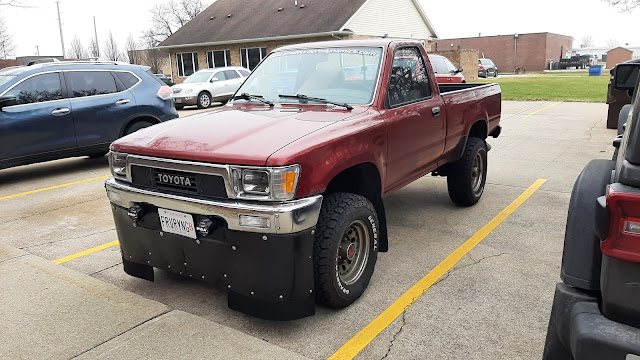Testing and Improving Stability: Part 3
In my first two posts on testing directional stability, I used
first a cellphone with angle measure and then a Scangauge
reporting steering angle from my car’s OBD system to try and
measure changes in its stability. That worked okay but I had no way of logging
data to verify that what I thought I saw on the gauge reflected a real change.
Not anymore. I bought an OBD Bluetooth scanner that connects to an
app that can log hundreds of different parameters through the car’s computers.
In this first test, I’ll see if I can use it to record steering angle in a
crosswind as I’ve been doing. To see just what it can show, I’ll first move my
car’s center of gravity around and record the differences.
How to Calculate the Position of Your Car’s Center of Gravity
Figuring out where your car’s center of gravity sits
longitudinally (that is, its location between the front and rear axles) is
quite simple. All you need are front and rear axle weights, something you can
get at any truck scale for around $15 USD. CAT scales are located across the
US; download the “Weigh My Truck” app, make an account, and you can weigh your
car just about anywhere without even getting out of it.
Before I stopped at the scale, I loaded up two big plastic bins
with books and bought some bags of top soil at the hardware store (I’ll use the
top soil later this spring in my garden). This gave me 320 lbf of ballast that
I could position at the very rear of my Prius, behind the rear axle, or just
behind the front seats near the center of the wheelbase. I weighed the car
first with the load at the rear and again with it at the center:
Then, I went online and looked up the wheelbase of my car. You can
usually find this on the manufacturer’s website if your car is newer;
otherwise, check car magazines or consumer review websites, anywhere that has
specifications or dimensions listed. The Prius’ wheelbase is 106.3 in, a
dimension it shares with many Japanese cars because of domestic regulations.
Next, I’ll draw a free body diagram (FBD) to
illustrate the external forces acting on the car as it sits on the scale. Note
that the axle weights the scale measures are actually the normal forces, the
forces exerted by the scale pushing up on the car, and its weight can be
represented as front and rear components at each axle or as total weight acting
at the center of gravity (aha!):
|
|
Front
Axle Weight (lbf) |
Rear
Axle Weight (lbf) |
|
Rear
Load |
1900 |
1680 |
|
Center
Load |
2000 |
1580 |
Unlike the process we used for coastdown testing (where the free
body diagram was set equivalent to a kinetic diagram representing
accelerations and masses), here there are no accelerations acting on my car—so that
side of the equation is 0. We can use this to figure xCG by setting
the forces equal to zero (since the car is not accelerating in any linear
direction) and moments equal to zero (since the car is not being rotated
in any direction):
{∑FY
= 0 = NR + NF – W
I’ve placed the reference here, O, at the rear axle, which gets rid of
the moment produced by NR, but you can place it anywhere you want and
the result will be the same. Be consistent with the directions of your moments
(here, I’ve used the standard positive = counterclockwise).
From there, simple algebra will give you the distance of xCG
from your reference. On my car, the rear load puts the center of gravity 56.4
in ahead of the rear axle (49.9 in behind the front axle), and the center load
moves it forward 3 inches (59.4 in ahead/46.9 in behind).
Crosswind Stability
Now, the question is: does moving the center of gravity three
inches and loading or unloading the front and rear axles with 100 lbf measurably
affect the stability of the car in a crosswind? To find out, I drove it on a
1-km section of E-W road on a day with 20 mph winds out of the SSW. Since I can
now log data from the OBD system, I exported it to my computer and graphed
steering angle as a function of time to compare the center load (heavier front
axle, center of gravity further forward) and rear load (lighter front axle,
center of gravity further backward) with no other changes to the car:






















Comments
Post a Comment